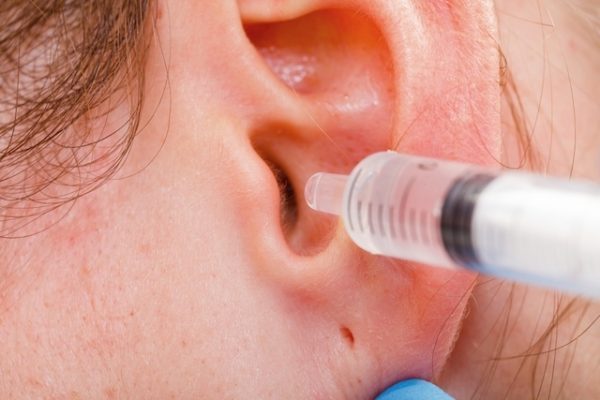Ear washing is a procedure that removes excess wax, but can also be used to remove any dirt that has accumulated in the ear canal over time.

However, rinsing should not be used to remove objects that have been inserted into the ear canal, as can happen with children. In such cases, one should go immediately to the otorhinolaryngologist, or to the pediatrician, to remove the object without causing lesions in the ear. See what to do in case of an insect in the ear.
Ideally, earwashing should be done by an otorhinolist, however, there are situations where the doctor may recommend doing the washing at home, giving the necessary indications to make the process safely.
Step by step to do the syringe wash
To make a safe ear wash at home you should follow the following steps:
- Fill a 20 mL syringe with water or saline heated to 37 ° C;
- Turn your head to the side and tilt it until the ear is washed face down;
- Put a basin under your ear or wash it over the bathroom sink, for example;
- Pull the ear back slightly to open the ear canal;
- Place the tip of the syringe near the opening of the ear canal and press the plunger;
- Keep the syringe plunger pressed to create a constant jet until the syringe is emptied.
- Repeat the previous steps to remove all wax from the ear.
To improve the effects of ear washing, a wax-softening product such as Cerumin, which can be purchased from pharmacies, should be applied. There are even washing solutions that can be purchased at pharmacies and already contain substances that help remove the wax more easily.
After washing, a small cotton ball should be placed at the entrance to the canal to absorb all the fluid and dry the ear canal, preventing otitis, for example.
What is washing for?
Excessive wax buildup in the ear can cause minor damage to the ear canal and hamper hearing, especially in people with very dry wax, so washing helps to reduce the risk of these changes.
In addition, and unlike the swab, it is also a relatively safe method of removing small insects or small pieces of food, preventing them from moving to a deeper location of the ear.
Although it is a simple technique, in most cases, washing does not have to be done at home, since the ear has natural mechanisms to remove the wax. Thus, this technique should only be used when it is indicated by the otorhinolaryngologist.
Possible risks
Ear washing is a fairly safe procedure, but there are also some risks, especially of:
- Ear infection: it occurs mainly when the ear canal does not dry properly after washing;
- Perforation of the eardrum: although it is rarer, it may occur if the washing is poorly done and the wax is pushed into the ear;
- Causes of dizziness: Washings may interfere with liquids naturally present in the ear, causing a temporary sensation of vertigo.
- Temporary hearing loss: if the wash causes some kind of inflammation in the ear.
Thus, although it may be done at home, ear washing should not be too frequent, since excessive wax removal is also not beneficial. Wax is naturally produced by the ear to protect the ear canal from lesions and infections.
Who should not wash
Although it is relatively safe, ear washing should be avoided by people with perforated eardrum, diabetes, weakened immune system or ear infection.
